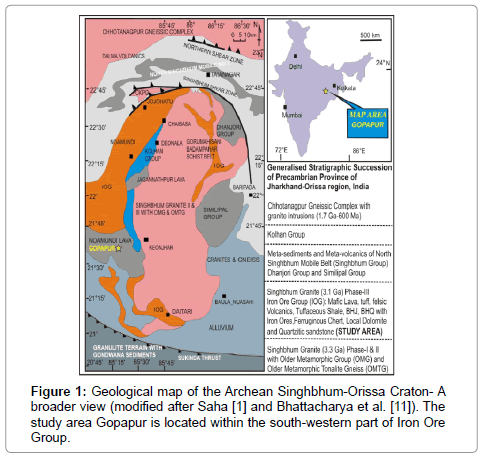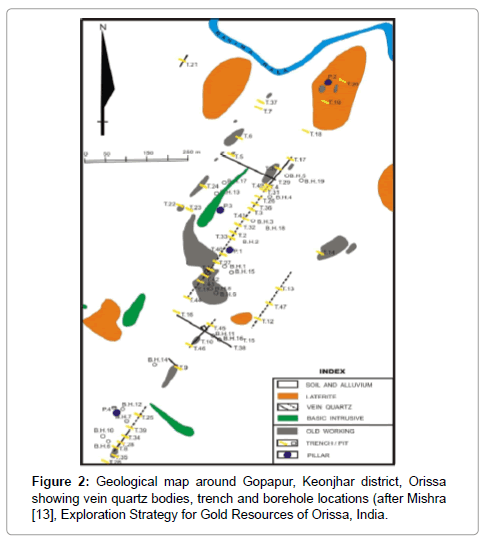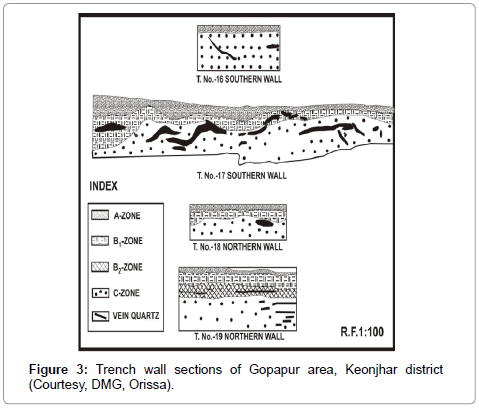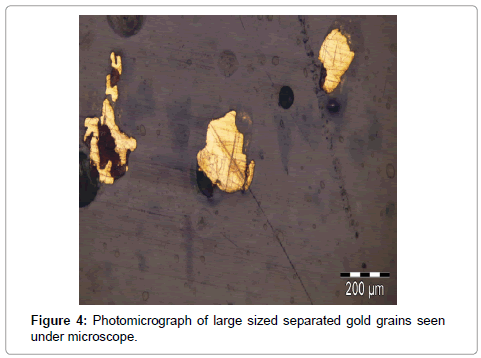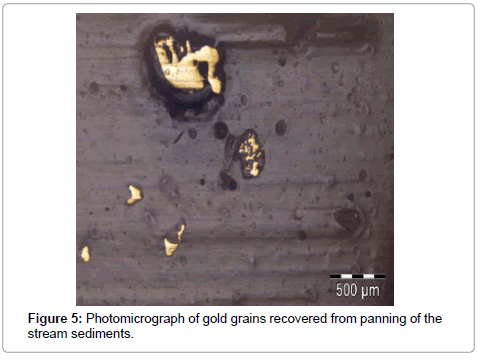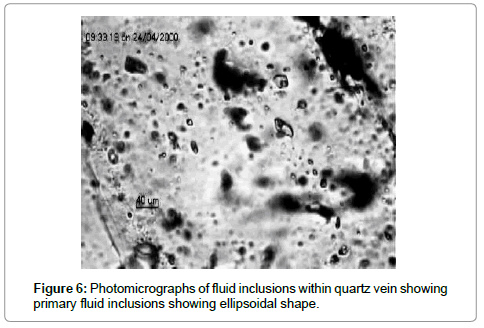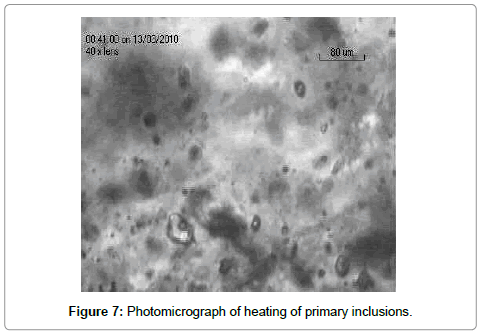Implications for Gold Mineralisation in the Gopapur Area, Keonjhar District, Orissa: A New Discovery
Received: 31-Aug-2015 / Accepted Date: 21-Sep-2015 / Published Date: 30-Sep-2015 DOI: 10.4172/2157-7617.1000304
Abstract
Gold deposits of Orissa can be broadly divided into three broad zones of Keonjhar, Mayurbhanj, and Sundargarh districts. In Keonjhar district gold occurrences have been reported from Saleikana-Dimirimunda-Kardangi sector in Telkoi block and Gopapur, Gajipur, Adal, Kushkala sector in Banspal block. Out of these localities Gopapur area seems to be the most promising one. The Precambrian metavolcanics of Gopapur in the Keonjhar district host auriferous quartz vein. In this area detailed exploration is carried out by GSI in 1:10000 scales with pitting, trenching, drilling, geological mapping and geochemical survey. The Quartz veins are found in the metavolcanics being emplaced along the prominent schistocity planes. Three sub parallel sets of quartz veins with high angle dip of are delineated. Gold mineralization is associated with the sulphides and oxides in quartz veins, basalts and laterites and ultramafic and is exposed on the surface as well as in underground trench faces. Gold occurs as refractory form and in free grains within quartz and intimate association with pyrite and chalcopyrite and oxides (haematite, goethite, magnetite and cuprite) in the form of refractory gold. The gold content of the mineralized quartz veins and lateritic wall rocks varies widely from 1 to 9 ppm. Fluid inclusion study shows the temperature ranges 250°C to 37°C and the gold deposit is of mesothermal type. The gold is formed by the remobilisation from sulphide bearing minerals to oxide bearing minerals. From the mineralogical and lithological assemblages the Gopapur prospect can be compared with Iron-formation-hosted vein and disseminated deposit that is Homestake gold deposit.
Keywords: Basalts; Eastern India; Gold, Iron ore group; Ultramafic rocks; Vein quartz
8988Introduction
India is the world’s largest consumer of gold in tonnage terms that is about 713 tons in 2008; hence there is an urgent need in augmenting gold exploration programmes in unexplored areas other than the southern Indian greenstone belts.
Review of the previous work
In 1977-78, at the time of field season of Geological Survey of India, Gopapur is explored in detail with 1:10,000 scale of mapping. Systematic cutting of trenches across the vein quartz at a strike interval of 30 metres was done to know the depth, continuity of the auriferous vein. About 90 samples were collected from the trench walls at 5 m interval. Geochemical sampling was done in Gopapur covering an area of 1.47 km2. Eighteen boreholes have been drilled by the Geological Survey of India in the area with their inclination angle ranging between 45o followed by core sampling. Boreholes were put at a strike interval of 100 m. 650 metres of strike length in the central block and 250 metres in the southern block of the main quartz reef of Gopapur area exhibits gold value of 1 g/t. A rich auriferous lode of 60 metres length with gold values varying from 2.5 to 10 g/t averaging 1 cm width has been delineated within the 250 metres length of lode in southern block. In central block a 4 m width lode has given average value 1.0 g/t. The following indications of auriferous lode in borehole-9 and borehole-11 are worth mentioning for the gold exploration in the area.
1. 2.5 meters thick lode in borehole-9 from 93.30 to 95.80 meters with gold value of 2.14 g/t.
2. 1 meter thick lode in borehole-11 from 29.00 to 30.00 meters with gold value of 5 g/t.
The panning of alluvial sediments has shown good results of up to 3 to 5 gm/t of gold.
Location and accessibility
Keonjhar town is situated on the national highway No. 6 in Orissa. Gopapur is situated 51 km. west of Keonjhar having longitude 85018’21’ and latitude 22036’39’ and is featured by 73G/6 top sheet number.
Stratigraphy
The Singhbhum-Orissa Craton (~40,000 sq. km.) of the eastern Indian shield is a Precambrian granite-greenstone terrain forming a triangular crustal block between latitudes 21º00´ and 23º 15´ N and longitudes 84º40´ and 86º45´ E [1]. The occurrence of the BIFs and associated iron ores around the Singhbhum granite is significant as their position in space and time is controversial. Dunn and Dey [2] established the intrusive relation of Singhbhum Granite with the IOG rocks. The spatial and temporal relationships between the different geological provinces and the stratigraphy within some of the provinces have been the subject of controversy for a long period of time and are not fully resolved (Table 1) (Figures 1 and 2).
| Unconformity Older metamorphic Group | |
|---|---|
| Recent to sub recent | Soil and alluvium |
| laterite | |
| Intrusives | Quartz vein (often auriferous) |
| Basic intrusives | |
| Granitoids and quartz porphyry | |
| Iron Ore Group | Basalts and Tuffs |
| Amphibolites, hornblende schist | |
| Quartz-sericite schist, quartzite | |
Table 1: Lithostratigraphic succession of the Gopapur area (after Behera [10]).
Exploration aspects and core drilling
Drilling in Gopapur area was initiated in July 1981. The total length drilled so far is 1723.85 meters. Nineteen bore holes were drilled in Gopapur area along the strike of the main lode at 100 meters spacing. The boreholes were inclined at 45º, intended to intercept the main lode at a depth of 30 meter and 60 meters vertical depth. The boreholes have intersected mineralized quartz veins in altered amphibolites and tuffs at various depths. Two deep pits were dug in Gopapur prospect going to depth of 12.00 m and 12.35 m. As evidenced from the deep pits, the vein quartz shows pinching and swelling character and swings from vertical to low angle dip on either direction. The litholog of the bore holes is given below. From the bore hole data it can be found out that gold mainly occurs in association with ambhibolites, mineralized quartz vein and in clay zones (Table 2). The zone of oxidation in the area extends up to 70 m. depth as evidenced from the boreholes (Figure 3).
| GROUP OF SAMPLES (COLLECTED FROM DIFFERENT PLACES) | SINK IN GRAMS | FLOAT IN GRAMS | TOTAL | % OF HEAVIES |
|---|---|---|---|---|
| QUARTZ - 1 QUARTZ - 2 | 0.77 0.41 |
220.84 115.56 |
221.6 115.96 |
0.35 0.352 |
| BASALT - 1 BASALT - 2 | 0.6 0.5 |
90.89 51.47 |
91.49 51.97 |
0.65 0.96 |
| ULTRAMAFIC - 1 ULTRAMAFIC - 2 | 0.14 0.23 |
61.36 138.63 |
61.51 138.86 |
0.23 0.17 |
| STREAM SEDIMENT – 1 STREAM SEDIMENT - 2 | 1.56 4.13 |
15.19 32.73 |
16.76 36.86 |
9.33 11.21 |
Table 2: Results of sink float tests.
Ore mineralogy and para genesis
More than 100 fresh rock/ore samples representing all the rock types were collected from the trench and old pits (depths varying between 2 to 5 m) of Gopapur area. The bulk, chip, channel samples were collected for mineralogical characterization and geochemical studies and were powdered to -200 mesh sizes for geochemical analysis. Mineralogical, textural association, deformation parameters and the presence or absence of gold register a three stage paragenetic order for the Gopapur area (Figures 4 and 5).
Stage I: The earliest minerals to form are quartz and ilmenite. The first formed sulphides occur in disseminated form which includes pyrite, sphalerite, pyrrhotite and chalcopyrite in the mafic rocks surrounding the auriferous quartz veins. This stage has some gold either in megascopic, microscopic or submicroscopic form and gold especially in refractory form have been obtained from EPMA analysis.
Stage II: This stage is dominated by oxide mineral phases that are restricted to the shear planes. The grain sizes of the sulphides have been marginally reduced in this stage. The gold is associated with haematite, magnetite and goethite to a lesser extent. The gold is formed by the remobilisation from sulphide bearing minerals to oxide bearing minerals. EPMA results indicate the presence of variable proportions of refractory gold values within oxides, which led to the formation of second phase of gold.
Stage III: Post depositional redistribution of the primary gold within the lattice structures of chalcopyrite and other sulphides resulted in the deposition of native gold. Native gold is present in the fractures and along the grain boundaries of the sulphides indicating late phase of formation of this gold. Presence of ore shoots with very high gold values occurs in this stage. This may be due to further remobilisation. Certain hydrothermally altered mineral phases denoting typical lode type mesothermal assemblages have also been observed among other gangue constituents [3].
Fineness of gold
Fineness of gold refers to the ratio of gold to the sum of gold and silver in the naturally occurring alloys and is defined as 1000 times Au / (Au+Ag). Fisher [4] noted that the fineness increases with increasing temperature of ore formation. He concluded that fineness of epithermal gold is from 500 to 700, in epithermal case 700 to 800, in mesothermal 750 to 900 and hypothermal gold greater than 800. In Gopapur the fineness of gold ranges from 750 to 900. This indicates mineralisation in the mesothermal state (temperature ranges 200 to 300°C).
Mineral Separation Experiments
Mineral separation experiments were conducted in the mineral beneficiation labs of Institute of Minerals and Materials Technology (IMMT, Bhubaneswar), Orissa using bromoform separation (sink float analysis), mainly to understand the nature and percentage of sulphide minerals and gold particles from amphibolites, quartz-sulfide veins and other mafic-ultramafic rocks. The study is aimed at finding out the separated fractions that includes the sulphides which bear the refractory/adsorbed gold, oxidised portions containing the gold and the free gold particles and to study their detailed microscopic characters, locking properties, and mineral-chemical information which gives a general idea about the depositional environment and transport mechanism with respect to primary and secondary mineral assemblages. Further the study is also intended to understand the locking properties and the amenability for beneficiation of gold from primary sulphides and secondary oxides.
Results of Bromoform Test
Bromoform tests have been conducted to know the percentage of heavies mainly the sulphides and oxides with the lighter minerals and to separate the minerals. The percentage of heavies is very less than the lighter particles in quartz, basalt and ultramafic samples. Since concentration of sulphide minerals are less in the collected samples, heavy media separation was carried out to get the sulphide and oxide minerals for microscopic characterization.
Electron Probe Micro Analyzer (EPMA) Results
EPMA analytical results reveal a maximum concentration of 4934 ppm of Au in iron phase in sink of ultramafic samples, 4457 ppm in the oxide phase in the sink of basalt, 3412 ppm in the sink of quartz samples and 2963 ppm in polished sections of ultramafic rocks (Table 3).
| Quartz sink(Cu,S,Fe,Au,Ni,O,Pb,As in wt% and Au in ppm) | ||||||||||
|---|---|---|---|---|---|---|---|---|---|---|
| Data Set/Point | Cu | S | Fe | Au | Ni | Pb | As | Total | One Minerals | |
| 1/1. | 35.71 | 34.77 | 29.47 | 500 | 0 | 0 | 0 | 100 | Chalco pyrite | |
| 2/1. | 0 | 0.3 | 96 | 300 | 2.37 | 0 | 0 | 100 | Iron phase | |
| 3/1. | 35.09 | 34.68 | 30.04 | 1500 | 0 | 0 | 0.035 | 100 | Chalco pyrite | |
| 4/1. | 0 | 53.68 | 46.07 | 1346 | 2.11 | 0.052 | 0.052 | 100 | Pyrite | |
| Quartz sink(Cu,S,Fe,Au,Ni,O,Pb,As in wt% and Au in ppm) | ||||||||||
| Data Set/Point | Cu | S | Fe | Au | Ni | O | Pb | As | Total | One Minerals |
| 1/1. | 1.1 | 0 | 68.5 | 0 | 0.1 | 29.9 | 0 | 0 | 100 | Hematite |
| 2/1. | 67 | 0.1 | 3.1 | 0 | 0.1 | 19.6 | 6.74 | 0.04 | 100 | Cuprite |
| 3/1. | 75.3 | 0 | 1 | 0 | 0.2 | 20.2 | 0.08 | 0.11 | 100 | Cuprite |
| 4/1. | 0 | 0 | 69.7 | 3000 | 0 | 29.9 | 0 | 0 | 100 | Hematite |
| 5/1. | 0.1 | 0.1 | 69.2 | 3000 | 0.2 | 29.9 | 0.06 | 0.05 | 100 | Hematite |
| 6/1. | 82.5 | 0 | 1.3 | 0 | 0.3 | 11.7 | 1.2 | 0.06 | 100 | Cuprite |
| 7/1. | 82.5 | 0 | 1 | 0 | 0.3 | 11.8 | 0.17 | 0.11 | 100 | Cuprite |
| 8/1. | 82.3 | 0 | 1 | 0 | 0.2 | 11.8 | 0.05 | 0.03 | 100 | Cuprite |
| 9/1. | 80 | 0.1 | 1.3 | 0 | 0.3 | 11.7 | 3.11 | 0.08 | 100 | Cuprite |
| Quartz sink(Cu,S,Fe,Au,Ni,O,Pb,As in wt% and Au in ppm) | ||||||||||
| Data Set/Point | Cu | S | Fe | Au | Ni | O | Pb | As | Total | One Minerals |
| 1/1. | 0 | 0 | 98.9 | 4458 | 0.37 | 0 | 0.03 | 0.074 | 100 | Iron phase |
| 2/1. | 0.47 | 0.06 | 65.11 | 0 | 1.65 | 29.98 | 0 | 0 | 100 | Hematite |
| 3/1. | 0 | 0.012 | 69.73 | 2783 | 0 | 29.87 | 0.11 | 0 | 100 | Hematite |
| 4/1. | 75.52 | 0.042 | 0.37 | 0 | 0.3 | 20.15 | 0.076 | 0 | 100 | Copper Phase |
| 5/1. | 74.33 | 0.1 | 4.52 | 99 | 0.22 | 11.96 | 5.3 | 0 | 100 | Copper Phase |
| 6/1. | 0.144 | 0.014 | 76.27 | 4171 | 0.49 | 22.16 | 0 | 0.12 | 100 | Iron phase |
| Quartz sink(Cu,S,Fe,Au,Ni,O,Pb,As in wt% and Au in ppm) | ||||||||||
| Data Set/Point | Cu | S | Fe | Au | Ni | Pb | As | Total | One Minerals | |
| 1/1. | 94.73 | 0.035 | 0.52 | 939 | 0.31 | 0.19 | 0.035 | 100 | Chalco pyrite | |
| 2/1. | 0.019 | 0 | 98.44 | 4934 | 0.74 | 0 | 0 | 100 | Iron phase | |
| 3/1. | 0.34 | 0.017 | 98.83 | 4295 | 0.17 | 0.034 | 0.034 | 100 | Iron phase | |
| 4/1. | 0 | 0 | 99.47 | 3579 | 0.08 | 0 | 0.1 | 100 | Iron phase | |
| 5/1. | 93.39 | 0.056 | 1.37 | 673 | 0.19 | 0.12 | 0 | 100 | Chalco pyrite | |
Table 3: Results of EPMA analysis.
Fluid Inclusion Characteristics
Fluid inclusions are the representatives of trapped portion of the liquids, gases, and melts from which the crystal had grown and could be used to establish the environment in which a rock or mineral might have been formed.
Fluid inclusion types at Gopapur area have been classified based on the geometry, phases, phase proportions, composition as type I type II (IIa and IIb) and type III (IIIa, IIIb and IIIc), as observed at room temperature.
Two hundred inclusions have been studied for conducting heating experiments (Figure 6).
Heating experiment
The heating studies are carried out on all the types of inclusions obtained in the Gopapur auriferous and barren quartz veins. The rate of heating is kept initially at 10°C to 15°C per minute to get uniform heating. The homogenisation data were checked at heating rate of 1°C to 5°C per minute to minimise the recording error. Repeated measurements were undertaken to minimise the error in data (Figure 7).
Gold Ores Of Probable Exhalative Origin And A Correlation With Homestake Deposit
The deposit of Gopapur can be compared with the Homestake gold deposit. The Homestake gold mine, South Dakota has produced over 1000 tons of gold since it started in 1877 (after Sawkins [5]). There is much similarity between Homestake deposits with the gold prospect of Gopapur. The ore bodies are restricted to auriferous, quartz schist unit within a thick sequence of metasedimentary and minor metabasic rocks. The package of rocks that hosts the gold deposits have been metamorphosed and deformed into a set of complex folds with high angle dips. Like the Homestake type, ore bodies are elongate, steeply plunging zones that appear to be localised by dilatant zones formed by superposition of F1 and F2 fold structures. This is suggestive of some remobilisation of gold during deformation. The ore bodies consist of quartz, chlorite in various proportions accompanied by little amount of pyrrhotite and chalcopyrite. The quartz occurs as both metamorphic segregations, which form irregular masses or short veins and recrystallised chart. Host rocks are oxide and sulphide facies iron formation, commonly at or near a volcanic-sedimentary contact. The deposits occur in regionally extensive banded iron formation at local sites of structural complexity such as fractures, joints and discordant shear zones. Strata-bound sulphide lenses consist of pyrite, pyrrhotite, chalcopyrite and native gold. Sulphidation of pre-existing iron-formation facies is most common adjacent to quartz veins, and chloritic alteration form distal envelopes in this deposit.
Possible Tectonic Set Up
Tectonic readjustment during the late stages of organic deformation, generally during regional uplift and retrograde metamorphism [6-8] have been considered an important factor for the formation of gold deposits. The deposit of Gopapur can be supposed to relate with the mantle activated rift zone. In the northern part there is the Singhbhum shear zone and in the southern part there is Sukinda thrust zone and apparently resembling a rift zone between these major tectonic features in which the gold deposition could have taken place. There may be some kind of rift like structure which can be formed by the tensile action within the plate. This can be evidenced by the deposition of different types of ores. Generally rift area shows high gravity anomaly and the subducted part gives negative gravity anomaly [9-15]. The area may be formed in the shallow basin with marine environment condition for which iron ore minerals along with sulphide bearing minerals are present. However, these would be testified only after detailed geochemical and geophysical surveys and warrants further isotopic investigations to understand the source of the fluids and metal.
Discussion and Conclusions
Gold mineralization in and around Gopapur area of Singhbhum organic belt is broadly controlled by litho-logical and structural features. The structural controls are favored by the localization of the mineralized quartz veins in the sheared fractures, precipitation of the gold and sulphides in the extensional fractures due to shearing. Fluid inclusion study shows the temperature ranges 175°C to 375°C and the gold deposit is of mesothermal type. From the mineral assemblages, EPMA data and paragenesis and from the fluid inclusion studies there seems to be two stages of gold deposition in this area: Refractory and Native gold form. Fluid inclusions that represent various stages of such modifications are indicators of the stages of evolution of mineralizing fluids and are likely to indicate the path of gold and other associated metals in the hydrothermal- geochemical cycles. Quartz veins acted as the carrier of mineralizing fluid. The pedological studies reveal that the mafic volcanic have been altered to a large extent due to metamorphism and hydrothermal alterations. Ore microscopic study reveals that sulphide minerals occurred within the mafic volcanic and as quartzsulfide veins. The gold is formed by the remobilisation from sulphide bearing minerals to oxide bearing minerals. EPMA results indicate the presence of variable proportions of refractory gold values within oxides. Low-salinity fluids produced by metamorphic devolatilisation provide a common theme embracing the formation of many Archean mesothermal gold deposits. The Gopapur prospect can be compared with Iron-formation-hosted vein and disseminated deposit that is Homestake gold deposit. This class of deposit consists of strata-bound, disseminated to massive sulphide lenses and discordant quartz veins in folded iron formation. Host rocks are oxide and sulphide facies iron formation, commonly at or near a volcanic-sedimentary contact. The deposits occur in regionally extensive banded iron formation at local sites of structural complexity such as fractures, joints and discordant shear zones. Strata-bound sulphide lenses consist of pyrite, pyrrhotite, chalcopyrite and native gold. Sulphidation of pre-existing iron-formation facies is most common adjacent to quartz veins, and chloritic alteration form distal envelopes in this deposit.
Acknowledgements
I am very much grateful to Dr. Banabehari Mishra, Reader in Geology, Dr. B. K. Mohapatra, Senior Scientist, IMMT, Bhubaneswar and Sri Prabodha Ranjan Sahoo (GSI) for helpful remarks, meticulous guidance, encouragement and suggestions.
References
- Saha AK (1994) Crustal evolution of Singhb hum-North Orissa, Eastern India. Memoir 27, Geological Society of India, Bangalore, 341p.
- Dunn JA, Dey AK (1942) Geology and petrology of Eastern Singhbhum and surrounding areas. Mem Geolo Surv India 69: 281-456.
- Saha I, Venkatesh AS (2002) Invisible Gold within sulfides from Archean Hutti- Muski schist belt, Southern India. J Asian Earth Sci 20: 449-457.
- Fisher NH (1950) Applications of gold fineness to the search for ore. Proc Aus Inst Min Metall 185-190.
- Sawkins FJ (1990) Metal deposits in relation to plate tectonics, second edition, pp 178.
- Grooves DI, Phillips GN (1987) The genesis and tectonic controls on Archaean gold deposits of the Western Australian Shield: a metamorphic- replacement model. Ore Geol Rev 2: 287
- Swager CG, Timothy J (1989) An early thrust duplex in the Kalgoorlie-Kambalda greenstone belt, Eastern Goldfields Province, Western Australia 48: 1-2.
- Hall KP, Mingos DMP (1984) Homo- and heteronuclear cluster compounds of gold. In S.J.Lippard, Ed., Progress in inorganic chemistry 32: 237-325.
- Banerjee PK (1982) Stratigraphy, Petrology and Geochemistry of some Precambrian basic Volcanic and Associated Rocks of Singhbhum District of Bihar and mayurbhanj and Keonjhar Districts, Orissa. Memoir Geological Survey of India, 111.
- Behera MD (2001) Report on investigation of gold in Gopapur area in Keonjhar District.
- Bhattacharya HN, Chakraborty I, Ghosh KK(2007) Geochemistry of some banded iron formations of the Archean supracrustals, Jharkhand-Orissa region, India. J Earth Systems Sci 116: 245-259.
- Iyengar SVP, Murty NGK (1982) The evolution of the Archean Proterozoic crust in parts of Bihar and Orissa, Eastern India. Rec Geol Surv India 112: 1-5.
- Mishra B (2005) Exploration strategy for gold resources of Orissa, India.
- Saha AK, Ghosh S, Dasgupta D, Mukhopadhyay K, Ray SL (1984) Studies on crustal evolution of the Singhbhum Oriassa Iron Ore Craton. Monograph on Crustal Evolution. Indian Soc Earth Sci 1-74.
- Saha I(2000) Metallogenic modelling of gold deposit in Hutti-Maski schist belt, Karnataka. Thesis submitted to Indian School of Mines, Dhanbad.
Citation: Kar M, Venkatesh AS (2015) Implications for Gold Mineralisation in the Gopapur Area, Keonjhar District, Orissa: A New Discovery. J Earth Sci Clim Change 6(9): 304 DOI: 10.4172/2157-7617.1000304
Copyright: © 2015 Kar M, et al. This is an open-access article distributed under the terms of the Creative Commons Attribution License, which permits unrestricted use, distribution, and reproduction in any medium, provided the original author and source are credited.
Select your language of interest to view the total content in your interested language
Share This Article
Recommended Journals
Open Access Journals
Article Tools
Article Usage
- Total views: 17947
- [From(publication date): 11-2015 - Aug 18, 2025]
- Breakdown by view type
- HTML page views: 16715
- PDF downloads: 1232

